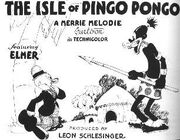Deprecated
We have moved to portable infoboxes using the new Template:Shorts
Please do not use this template anymore. It is left here for reference purposes.
| The Isle of Pingo Pongo | |||||||||||||||||||||||||||||||||||||||||||||
| |||||||||||||||||||||||||||||||||||||||||||||
|
Blue-Ribbon Re-Issue Titles


Lobby Card
The Isle of Pingo Pongo is a 1938 Warner Bros. cartoon directed by Tex Avery. It is the first of Avery's spoofs of travelogues. The cartoon was banned from TV syndication in 1968 by United Artists (the owners at the time) for racist depictions of black people and is one of the "Censored Eleven". UA believed that no amount of editing could make it allowed to be distributed on United States television.
This is the final Merrie Melodies cartoon to end with RELEASED BY WARNER BROS. PRODUCTIONS CORP and the last cartoon to have the lowercase f in "That's all Folks!".
Plot
The short follows a cruise ship’s trip from New York to the island, presumably located in the South Seas. The ship sails past the Statue of Liberty, who acts as a traffic cop, past the “Canary Islands” and “Sandwich Islands,” and the overall story was less plausible than some of Tex Avery's other cartoons.[1]
The cartoon revolves around themes of jazz and primitivism, and is set on a remote island. The central character is an early version of Elmer Fudd known as Egghead, and most of the cartoon consists of travelogue-type narration and blackout gags, many including Egghead. The inhabitants of Pingo-Pongo are mostly tall, black, and have big feet and lips. Like other cartoons at this time, the native inhabitants resemble animals and reflect stereotypes of the time. The natives are at first playing drums, then break into a jazz beat, still described as a “primitive savage rhythm,” which leads the audience to connect the savage jungle to modern jazz music. [2]
This is one of Avery's first travelogues and Egghead's running gag where he says, "Now Boss?", but the narrator keeps saying not now, until the sun didn't go down. Egghead then shot the sun and the film ended.
Bans
The ban has been upheld by the cartoon's successive owners and is unlikely to be released on home video, however, as The New York Times [1] reports, unauthorized copies are relatively easy to find. The cartoon was reissued as a Blue Ribbon Classic, however, the original titles are known to exist. There is the original titles recreation on YouTube, with the title card showing up during the MM song playing, then forwarding to where the blue ribbon started.
The short in its 1944 reissue can be easily found on DailyMotion. There are 2 copies, 1 in good condition, the other is a poor bootleg copy. Additionally, the short was recently viewed with 7 films part of the Censored Eleven at the TCM Film Festival in Hollywood on April 24, 2010 as part of a classic film series, presented by Donald Bogle. It is unknown if the original titles have been restored for the future DVD release. The release has yet to come, but Jerry Beck said transfers are done with a few extra banned films owned by WB, they just have to release it soon.
A higher quality copy can be found here: www.dailymotion.com/video/x3qqpyp
References
- ↑ Barrier, Michael. Hollywood Cartoons: American Animation in Its Golden Age. Oxford University Press, 2003. page 343
- ↑ Goldmark, Daniel (2005). Tunes for 'toons: Music and the Hollywood Cartoon. University of California Press, page 91-92. ISBN 0520236173.

